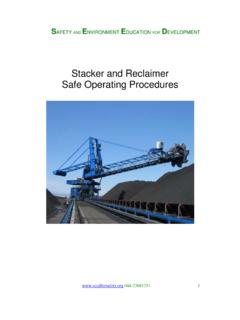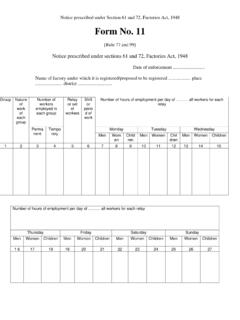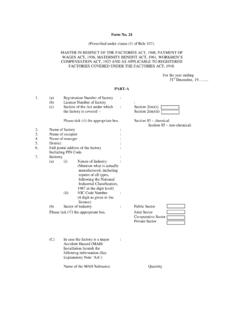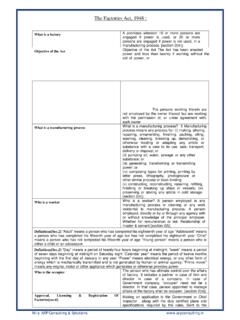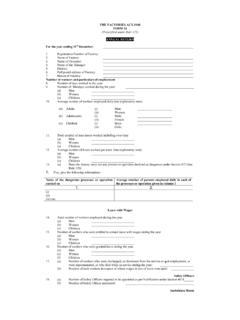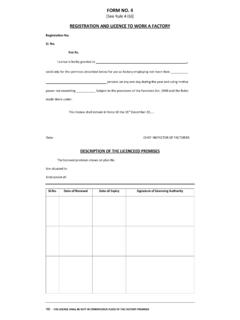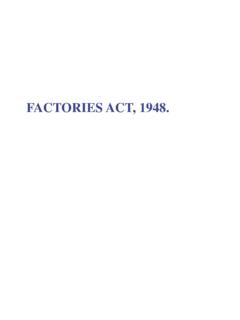Transcription of FACTORIES ACT CHAPTER 104, SECTION 102 1 FACTORIES …
1 FACTORIES ACT ( CHAPTER 104, SECTION 102 (1)) FACTORIES ( noise ) regulations - 1 - FACTORIES ACT ( CHAPTER 104, SECTION 102 (1)) FACTORIES ( noise ) regulations [1st January 1997] Arrangement of Provisions PART I PRELIMINARY 1 Citation 2 Definitions 3 Application PART II noise CONTROL 4 Duties of occupier and employer 5 Duties of suppliers of machines or equipment PART III noise MONITORING, HEARING PROTECTORS AND TRAINING 6 noise monitoring 7 Hearing protectors 8 Training FIRST SCHEDULE PERMISSIBLE EXPOSURE LIMITS FOR noise SECOND SCHEDULE FACTORIES ACT ( CHAPTER 104) FACTORIES ( noise ) regulations noise MONITORING REPORT FACTORIES ACT ( CHAPTER 104, SECTION 102 (1)) FACTORIES ( noise ) regulations - 2 - Actual Provisions PART I PRELIMINARY Citation 1.
2 These regulations may be cited as the FACTORIES ( noise ) regulations . Definitions 2. (1) In these regulations , unless the context otherwise requires "A-weighted sound pressure level" means sound pressure level measured by an instrument with an electrical network having the characteristics specified in the International Electrotechnical Commission (IEC) Publication 651; "dB(A)" means decibels of A-weighted sound pressure level; "equivalent sound pressure level" , in relation to a fluctuating sound pressure level, means a constant sound pressure level measured over a duration of time having the same cumulative acoustic energy as the fluctuating sound pressure level measured over the same duration. (2) For the purposes of these regulations (a) a person shall be deemed to be exposed to excessive noise where the noise that he would be exposed to, if he was not wearing any hearing protector, exceeds the permissible exposure limit for noise specified in the First Schedule or, if the noise is at a fluctuating sound pressure level, the equivalent sound pressure level of 85 dB(A) over an 8-hour work day; and (b) the sound pressure level (SPL) shall be calculated according to the following formula: where log is the common logarithm; P is the sound pressure; and Po is the standard reference pressure of 20 microPascals.
3 Application 3. These regulations shall apply to all FACTORIES where any machinery, equipment or process used is likely to expose any person to excessive noise . FACTORIES ACT ( CHAPTER 104, SECTION 102 (1)) FACTORIES ( noise ) regulations - 3 - PART II noise CONTROL Duties of occupier and employer 4. (1) The occupier or employer must take all practicable measures to reduce or control noise from any machinery, equipment or process such that no person employed or working in the factory is exposed to excessive noise . (2) The measures to be taken under paragraph (1) must include one or more of the following where appropriate: (a) replacing noisy machinery, equipment or processes with less noisy machinery, equipment or processes; (b) locating noise sources away from hard walls or corners; (c) isolating noise sources such that a minimum number of persons employed or working in the factory are exposed to the noise ; (d) constructing suitable acoustic enclosures to contain noise emitted by machinery, equipment or processes; (e) erecting an effective noise barrier larger in size than the noise source to provide acoustic shielding.
4 (f) operating pneumatic machinery, equipment or tools at optimum air pressure to minimise noise emission and installing suitable pneumatic silencers at pneumatic line outlets; (g) installing mufflers at intake and exhaust openings that emit noise ; (h) mounting vibrating machinery on vibration isolators or separate foundations; (i) isolating persons employed or working in the factory in an acoustically shielded room or enclosure, where reduction of noise at the noise source is not practicable; (j) lining hard surfaces with acoustically absorbent materials to reduce noise reverberation; (k) isolating or reducing the size and vibration of vibrating surfaces or applying damping materials to vibrating surfaces; (l) reducing the height from which objects are allowed to fall or applying a resilient material at the point of impact or at the point of interaction of moving objects; or (m) maintaining machinery and equipment at regular intervals to reduce noise emission.
5 (3) Where it is not practicable to reduce the noise , the occupier or employer must limit the duration of time persons employed or working in the factory are exposed to the noise so that such persons are not exposed to excessive noise . (4) No occupier or employer shall cause any machinery, equipment or process (not in use in the factory before 1st January 1997) to be used in any factory if any person employed or working in the factory will thereby be exposed to excessive noise , unless the machinery, equipment or process incorporates or is used in conjunction with all the means of reducing noise applicable to such machinery, equipment or process which are available whether in Singapore or elsewhere. (5) Where 50 or more persons employed or working in the factory are exposed or are likely to be exposed to excessive noise , the occupier or employer must appoint a person, having such qualifications or experience as the Chief Inspector may require, to advise him on all proper noise control measures.
6 FACTORIES ACT ( CHAPTER 104, SECTION 102 (1)) FACTORIES ( noise ) regulations - 4 - Duties of suppliers of machines or equipment 5. Any person who supplies any machine or equipment for use in any factory which is likely to expose any person to excessive noise must furnish to the person to whom the machine or equipment is supplied such information concerning the sound level which is likely to be generated by the machine or equipment and label the machine or equipment in such manner as the Chief Inspector may require. PART III noise MONITORING, HEARING PROTECTORS AND TRAINING noise monitoring 6. (1) Where 10 or more persons employed or working in the factory are exposed or are likely to be exposed to excessive noise , the occupier or employer must cause noise monitoring to be carried out at least once every 3 years, or earlier if any change in machinery, equipment, processes, controls or other conditions is likely to cause any such person to be exposed to excessive noise .
7 (2) The occupier or employer must (a) appoint a person to conduct the noise monitoring and prepare a report in the manner specified in the Second Schedule; (b) not later than 14 days after the preparation of the report, communicate the contents of the report to all persons employed or working in the factory who have been exposed to excessive noise ; (c) submit a copy of the report to the Chief Inspector; and (d) keep the report available for at least 10 years. Hearing protectors 7. (1) The occupier or employer must provide suitable hearing protectors to all persons employed or working in the factory who are exposed or are likely to be exposed to excessive noise . (2) Hearing protectors provided under paragraph (1) must (a) correctly fit the user; (b) attenuate the exposure of the user to sound pressure levels below 85 dB(A); (c) be compatible with the job requirements of the user; and (d) not prejudice the health and safety of the user.
8 (3) The occupier or employer must establish and implement procedures to ensure that (a) hearing protectors are properly issued and maintained; (b) persons employed or working in the factory who are exposed or are likely to be exposed to excessive noise levels use hearing protectors; and (c) such persons are instructed in the proper use of the hearing protectors. (4) The occupier or employer must cause warning signs to be posted at all entrances to or at the periphery of all areas in which persons will be or are likely to be exposed to excessive noise , which clearly indicate that hearing protectors must be worn in such areas. FACTORIES ACT ( CHAPTER 104, SECTION 102 (1)) FACTORIES ( noise ) regulations - 5 - Training 8. (1) The occupier or employer must institute a training programme for persons employed or working in the factory who are exposed or are likely to be exposed to excessive noise and ensure that all such persons attend the training.
9 (2) The training programme must include instruction in the following: (a) the relevant provisions of the Act and these regulations ; (b) the effects of noise on hearing; (c) the purpose of hearing protectors, the advantages and disadvantages and attenuation of various types of hearing protectors and the selection, fitting, use and care of such hearing protectors; and (d) the purpose of hearing tests and the appropriate procedures and requirements of such tests. (3) The training must be conducted for every such person employed or working in the factory at least once every 3 years and, for such persons commencing work in the factory after 1st January 1997, must be first conducted within 3 months of such commencement. (4) The occupier or employer must ensure that persons appointed under regulation 4 (5) or 6 (2) attend such training as the Chief Inspector may require.
10 FACTORIES ACT ( CHAPTER 104, SECTION 102 (1)) FACTORIES ( noise ) regulations - 6 - FIRST SCHEDULE Regulation 2 (2) PERMISSIBLE EXPOSURE LIMITS FOR noise Sound pressure level, dB(A) Maximum duration per day 85 8 hours 86 6 hours 21 minutes 87 5 hours 2 minutes 88 4 hours 89 3 hours 11 minutes 90 2 hours 31 minutes 91 2 hours 92 1 hour 35 minutes 93 1 hour 16 minutes 94 1 hour 95

